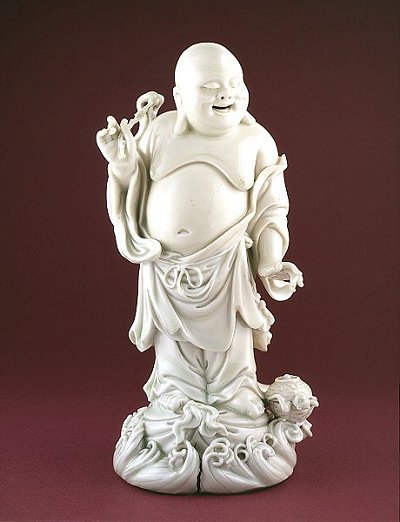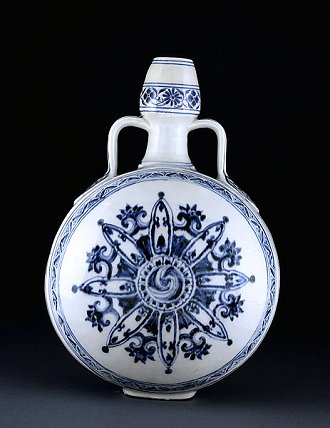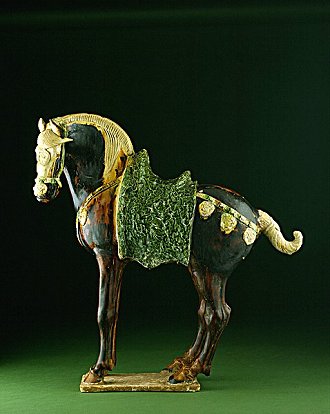Questions for "Of Hands and Fire, Masterpieces of Chinese Ceramics: The Koger Collection from the John and Mabel Ringling Museum of Art"
A temporary exhibition, held at The John & Mable Ringling Museum of Art in 2003
 |
Produced by Oaklianna Brown, Cassidy Follins, and Nicole Stephens for the Spring of 2004 These questions are meant to elicit thought about some of the issues manifested in the work of the Koger Collection. It is not necessary to have background knowledge of art—merely a healthy curiosity. It is important for you to view the show before looking at these questions. Draw your own conclusions before using this to facilitate a deeper understanding of the collection. Our goal is not to tell you what to think but to help you in clarifying your own conclusions. |
1. The current exhibition comes from the collection of Nancy and Ira Koger, two avid
collectors of Chinese ceramics, American Impressionistic art, and 18th century furniture.
In 2001, the Kogers donated their world-renowned Chinese ceramics collection to the
Florida State University and Ringling Museums. The Kogers utilized a “discerning
eye” in choosing each piece for their collection. As you look around the exhibit,
consider the criteria by which the Kogers assembled their collection. Consider the
following:
a. In addition to their Chinese origin, what similarities do the art pieces share? Do you
notice any common features? What are the differences? Are there any unique features to a
specific piece?
b. Do you think the Kogers selected the objects based on beauty or monetary value? Can you
find any objects in the collection chosen for either reason? Why do you think this?
c. If you were a collector, how would the collection differ? Would you base your decisions
on beauty or value? What unique or common features would attract you to a piece?
2. Most of the pieces in the exhibit serve a utilitarian purpose, either common or
religious; yet, they also show that the artists were concerned with the aesthetics of
their work. A piece can have one of three main functions. It can be ceremonial, being used
mainly for religious rituals or festivals. It can have a common function, meaning it is
intended for everyday usage. It can also be decorative, meant mainly for aesthetic
adornment. The function of the object depends upon its culture of origin, the materials
from which it is made, and the wealth of its intended owners. Choose three pieces from the
exhibit, and consider the following:
a. What is the object’s primary function (ceremonial, common, or decorative)? What
makes you think it belongs to this category? Could it have a secondary function? Why or
why not?
b. Are there any specific pieces in which aesthetics are more important than function? Why
do you say this?
c. How does the application of the elements of design (listed below) change the style of a
piece? Considering objects with the same function, how do the elements of design differ?
How is this affected by the intended recipient of the piece?
Elements of Design:
- Line
- Shape
- Space
- Texture
- Color (Hue & Intensity)
- Value (Lights/Darks)


3. When European trade with China began, ceramics were one of the popular items shipped
from China to Europe. One such type of ceramic was the Ming porcelain. Ming porcelain
(made between 1386 and 1644) was known for its uniformity and bold us of colored glazes,
especially blue. The Ming porcelains did not remain the same after export from China. Once
in Europe, silver bases and handles were often added. This technique of adding silver
continued well after 1644 and spread to other types of porcelain.
a. Find an example of Ming porcelain that was not altered to suit European taste and one
that was altered. (Hint: Look in the middle room of the upstairs gallery). Compare.
b. Do you think the silver enhances the beauty or detracts from the original beauty? Are
there any pieces you think would be enhanced by adding silver?
4. Chinese culture is full of symbolism. A dragon, for example, is a symbol of wealth and
wisdom. A benevolent monster, the dragon presides over the four corners of the world.
Five-clawed dragons symbolize the imperial court, while common dragons have only three or
four claws. However, the dragon is only one of the innumerable supernatural and earthly
flora and fauna to which the Chinese associate specific powers.
a. Find an example of an imperial and a common dragon. Are the imperial dragons reserved
for pieces with a specific function? Or can any symbol be found on any piece?
b. What other motifs and colors do you suspect to be symbols? What could these symbols
mean? Could the shape of the vessels themselves be symbols?
c. Consider the symbols listed below while you look at several pieces in the exhibition.
Do your interpretations differ from those of the Chinese? Which interpretation do you
prefer? Do you need to understand the symbolism to appreciate the work? Why or why not?
Symbols:
Bamboo – A third century publication, Treatise on Bamboo, listed 1,001 uses
for the indigenous plant grown throughout China. It is utilized in all aspects of everyday
life: as food, housing, tools and utensils, medicine, and transportation.
Carp – The long-living carp (goldfish) is respected as an emblem of vigor,
endurance, and power.
Crane – These icons of longevity and age are often depicted in conjunction
with pine trees and are frequently found on coffin lids, because they officially carry
departed souls to heaven.
Ferghana Horse – This is a type of horse from Central Asia that was
considered larger and hardier than native horses. It was popular for military use and was
often depicted carrying warriors in Chinese art.
Flowers – Vegetation is a crucial element in Chinese symbolism; a different
flower represents each month and season. Commonly depicted flowers are the lotus, peach,
peony, persimmon, plum, pomegranate, and rose. They represent such ideals as abundance,
marriage, love, joy, feminine beauty, and even the spirit of the perfect human.
Phoenix – This mythical animal is a combination of the pheasant and the
peacock. It rules the southern quadrant of the heavens, is associated with the summer and
the sun, and symbolizes eternal love.
http://www.mofa.fsu.edu/questions.html